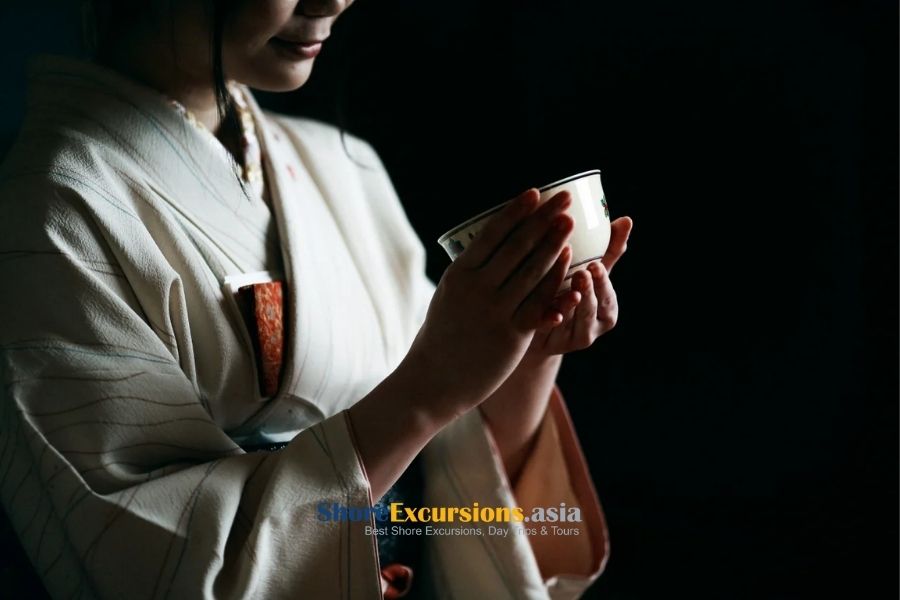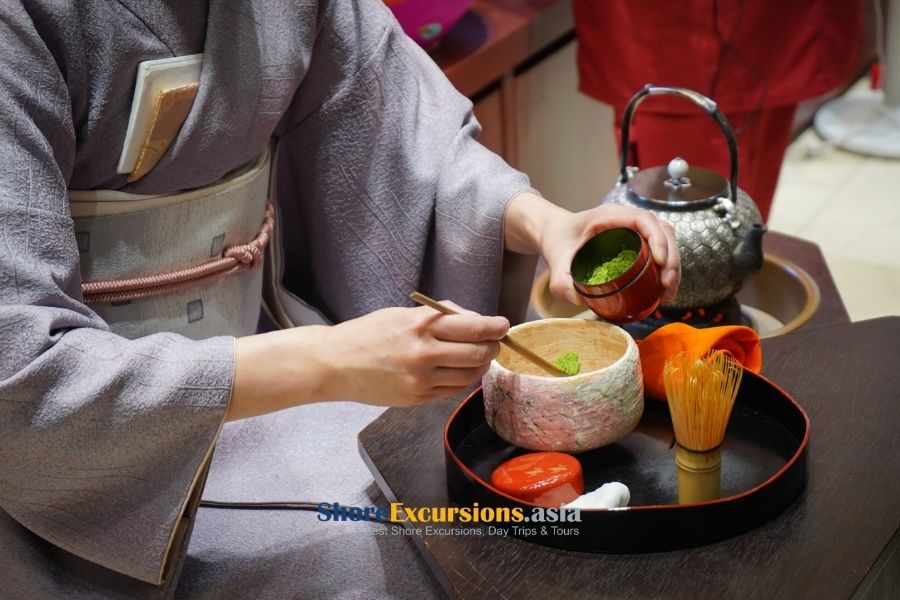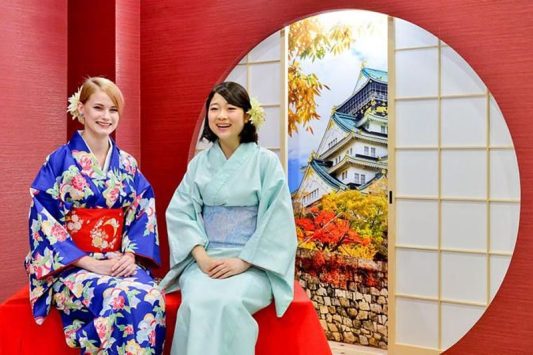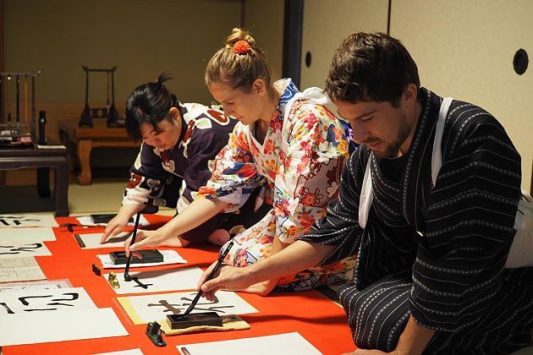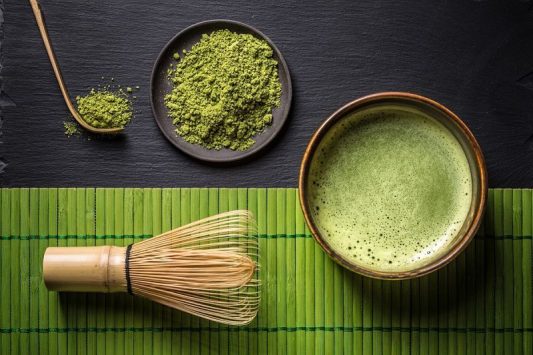Experience the Japanese tea ceremony (Chado or Chanoyu) with Japan Shore Excursions, a timeless ritual of matcha, mindfulness, and harmony. Rooted in Zen and simplicity, this cultural treasure reflects Japan’s deepest values. In this guide, uncover its meaning and learn how you can join an authentic ceremony on your journey.
What is the Japanese Tea Ceremony?
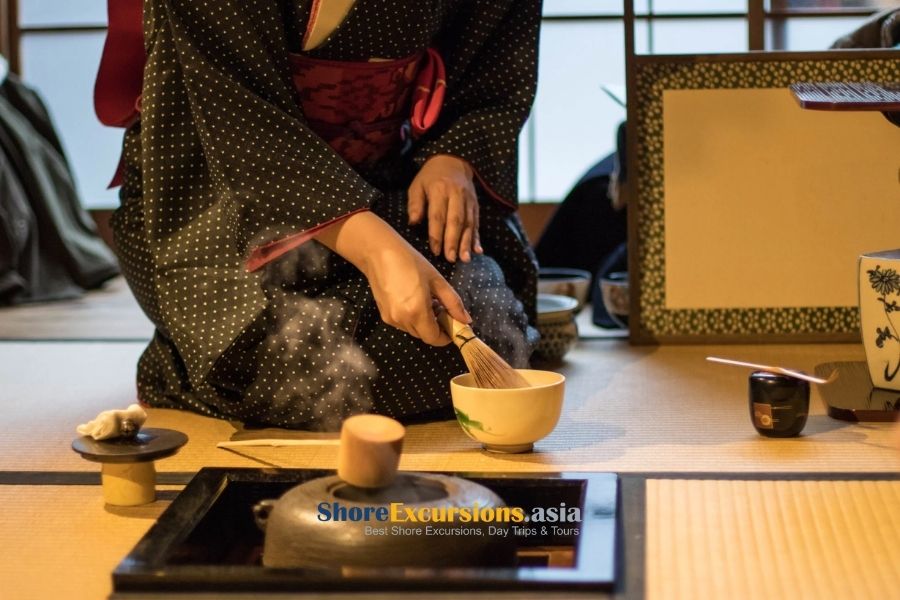
The Japanese Tea Ceremony, often referred to as chanoyu (茶の湯), sado (茶道), or chado, is a traditional cultural practice centered around the preparation and sharing of powdered green tea (matcha). However, it is much more than the act of serving and drinking tea. It is a refined ritual that embodies mindfulness, respect, and aesthetic appreciation. Guests are not simply offered a beverage; they are welcomed into a carefully orchestrated experience where every gesture and movement conveys harmony and tranquility.
Rooted in Zen Buddhism, the ceremony was shaped by tea masters such as Sen no Rikyū during the 16th century, who emphasized simplicity, humility, and mindfulness in every aspect of the ritual. The practice evolved into a way of cultivating inner calm, strengthening human connections, and appreciating the fleeting beauty of the present moment.
The Japanese tea ceremony is known by two main names, each highlighting a different dimension of the tradition:
- Chado (The Way of Tea): Focuses on the deeper philosophy, presenting tea as a lifelong path of discipline and spiritual growth.
- Chanoyu (Hot Water for Tea): Refers more to the practice itself: the preparation, presentation, and enjoyment of matcha.
Together, Chado and Chanoyu reveal that the Japanes tea ceremony is not just about drinking tea, but about embracing a way of life centered on simplicity, balance, and respect.
A Brief History and Core Philosophy of the Japanese Tea Ceremony
The story of the Japanese tea ceremony begins many centuries ago, when Buddhist monks carried powdered green tea (or matcha) from China to Japan during the late Heian and early Kamakura periods. In the quiet halls of monasteries, this tea was used to support meditation, helping monks remain calm, focused, and spiritually centered.
Over time, the habit of drinking tea spread from temples to the elegant gatherings of the samurai and aristocracy. What began as a humble drink soon grew into a symbol of refinement, discipline, and cultural pride. These early practices eventually blossomed into the structured rituals that form the foundation of today’s Japanese tea ceremony.
At its heart, the Japanese green tea ceremony reflects a philosophy shaped by Zen Buddhism, finding beauty in simplicity, balance in everyday moments, and mindfulness in every movement. With each passing generation, this philosophy transformed tea from a daily beverage into an art form. More than just drinking matcha, the Japanese tea ceremony became a way to celebrate harmony, respect, and the quiet connections that bring people together.
Matcha - The Heart of Tea Ceremony in Japan
If the tea ceremony has a soul, it is surely found in matcha. This bright green tea powder that has long been a symbol of elegance and mindfulness in Japanese tea culture. Unlike everyday loose-leaf tea, matcha is made from shade grown leaves that are carefully picked, steamed, dried, and then stone-ground into a fine powder. This unique form gives matcha its vivid color, delicate aroma, and smooth taste.
The Essence of Matcha
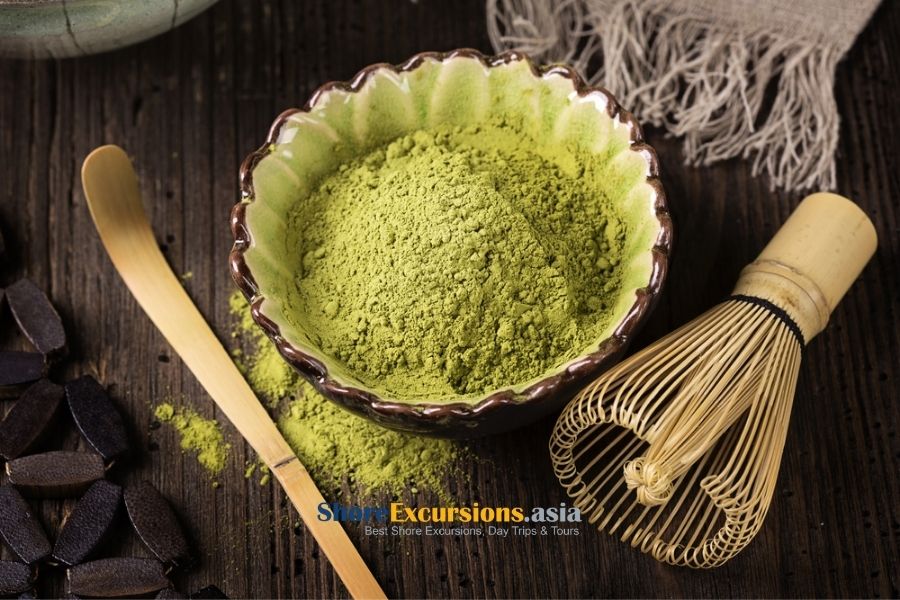
Matcha is unique among teas because the whole leaf is consumed, offering both a rich flavor and a deeper connection to nature. Its vivid green color symbolizes vitality and renewal, while its slightly bitter taste encourages guests to pause, reflect, and embrace simplicity. Unlike everyday beverages, matcha in the Japanese tea ceremony is not hurriedly consumed; it is savored slowly, with full awareness of the moment.
Preparing Matcha
The host carefully measures the powdered tea into a handcrafted bowl (chawan), adds hot water, and skillfully whisks it with a bamboo whisk (chasen) until a smooth, frothy surface appears. This process is not only about technique but also about intention: every movement reflects precision, grace, and a deep respect for the guest. Watching the preparation of matcha in Japan tea ceremony is as meaningful as drinking it, since the ritual itself cultivates mindfulness and appreciation.
Sharing Matcha
Once prepared, the bowl of matcha is offered to the guest, who accepts it with gratitude, turns it slightly before drinking (to show respect for the artwork of the bowl), and takes quiet, measured sips. This exchange is intimate and symbolic, a gesture of hospitality and mutual respect that transforms tea into a shared experience of harmony.
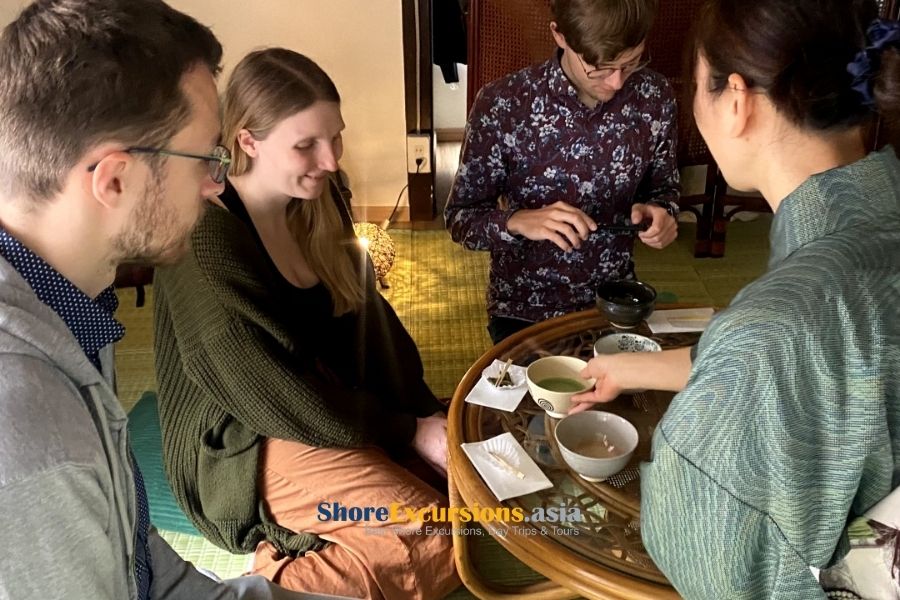
Symbolism of Matcha in the Ceremony
Beyond taste and appearance, matcha embodies the philosophy of the tea ceremony. It reflects the Zen-inspired principles of wabi-sabi (beauty in imperfection) and ichi-go ichi-e (the idea that each meeting is unique and unrepeatable). A single bowl of tea thus becomes a reminder to appreciate the fleeting nature of life, to live fully in the present, and to cherish human connection.
Immerse Yourself in the Japanese Tea Ceremony
To take part in the Japanese tea ceremony on Kyoto shore excursions is to step into a world of calm, beauty, and mindfulness. More than a cultural tradition, it is an immersive experience where every detail invites you to slow down, be present, and discover harmony in simplicity.
Entering the World of Tea
Joining a Japanese tea ritual feels like stepping into a peaceful realm of simplicity and calm. The ceremony is often held in a chashitsu (tea house) - a minimal, meditative space designed to quiet the mind. Before reaching it, guests walk along a roji (garden path) symbolizing purification and the act of leaving behind daily distractions. Inside, silence, natural beauty, and balance create the perfect setting for the ritual.
A Journey Through the Japanese Ritual
Each gathering unfolds slowly and with intention. Guests begin by purifying themselves, often through a bow or a simple washing of the hands. The host prepares matcha with graceful, meditative movements.
When the tea is served, it is exchanged with bows of respect, and each sip is taken with gratitude. What seems like an ordinary drink transforms into a mindful moment of connection. The ceremony closes quietly, leaving participants with a lingering sense of harmony and inner peace.
Tools That Tell a Story
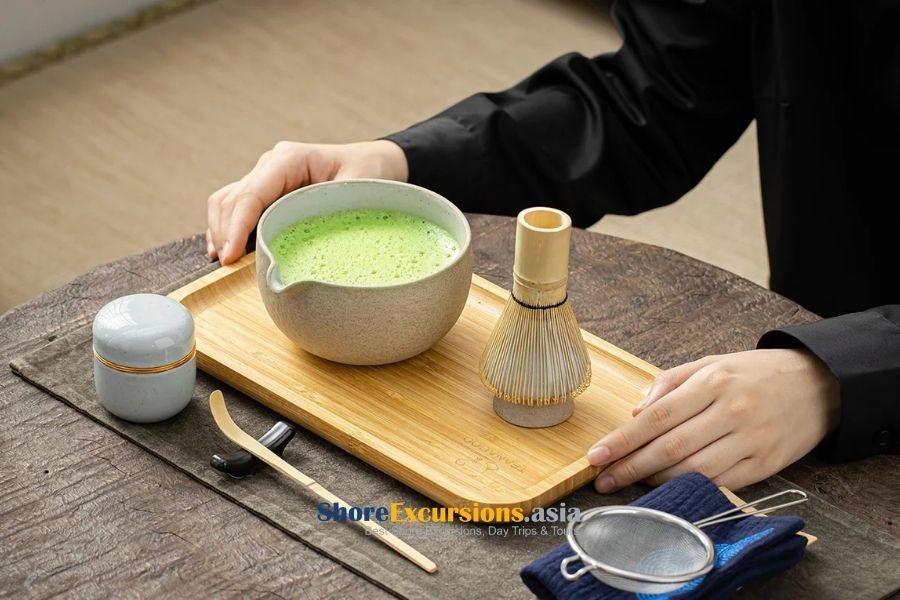
The utensils used are more than functional objects, they embody Japanese craftsmanship and the beauty of wabi-sabi. The chawan (tea bowl) is admired for its unique form; the chasen (bamboo whisk) brings the tea to a frothy life; and the chashaku (tea scoop) measures matcha with precision. Each tool turns the act of preparing and drinking tea into a ritual of elegance and meaning.
For travelers, a Japanese tea ceremony is not just about tasting matcha. It is about stepping into a living tradition where silence, beauty, and hospitality come together. Experiencing this centuries-old practice during your shore excursion Japan is one of the most memorable ways to connect with Japan’s culture.
Exploring the Many Forms of the Tea Ceremony
Over the centuries, the traditional Japanese tea ceremony has evolved into different styles, each offering its own way of expressing hospitality, mindfulness, and cultural beauty. While all forms share the same spirit, the experience and focus can vary.
The Traditional Japanese Tea Ceremony
The traditional Japanese tea ceremony is the form most closely tied to Zen philosophy and the teachings of tea master Sen no Rikyū. It emphasizes harmony, respect, and the appreciation of subtle, seasonal beauty.
Guests on shore excursions may join a formal chaji, a full-length ceremony lasting several hours with a meal included, or a more relaxed chakai, a shorter gathering focused on tea and sweets. In both cases, the heart of the ritual remains the same, welcoming guests with sincerity and creating a mindful space where every sip feels special. Join Japanese Tea Ceremony on Hiroshima shore excursions with us to experience the true Japan.
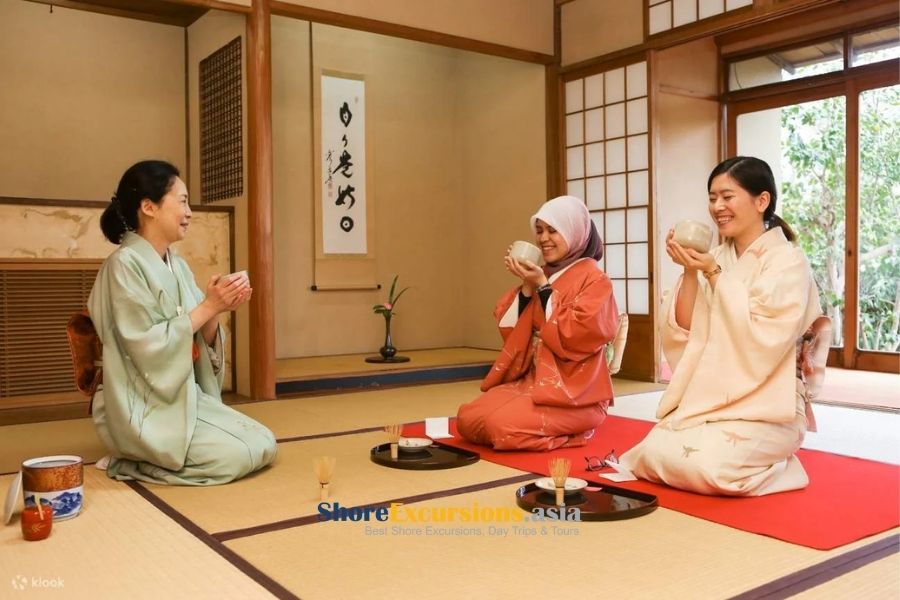
The Japanese Matcha Tea Ceremony
The Japanese matcha tea ceremony shines a spotlight on the preparation and enjoyment of powdered green tea, or matcha, which is central to Japanese culture. During the ritual, the host measures out the fine powder, places it in a handcrafted bowl, and whisks it with hot water until a frothy, emerald-green surface appears.
The sound of the bamboo whisk, the warmth of the bowl in your hands, and the delicate aroma of matcha together create a sensory experience that feels both grounding and uplifting. For many travelers, this moment is often remembered as the highlight of their cultural journey in Japan.
Traditional Matcha Tea Ceremony vs. Traditional Matcha Ceremony
Although the terms are often used interchangeably, there is a subtle difference between the traditional matcha tea ceremony and the traditional matcha ceremony. The traditional matcha tea ceremony refers specifically to the step-by-step ritual of preparing, presenting, and drinking tea with careful etiquette.
By contrast, the traditional matcha ceremony can describe the broader cultural practice of enjoying matcha in various contexts, from seasonal festivals to intimate family gatherings. Both highlight the importance of matcha in Japanese life, but one focuses on ritual precision while the other reflects cultural tradition in everyday settings.
Top Tea Ceremony Shore Excursions for Cruisers
There’s no better way to enrich your cruise journey in Japan than by pairing sightseeing with the serenity of a traditional tea ceremony. With Japan Shore Excursions, cruise guests can enjoy tours designed especially for travelers arriving by ship, combining cultural highlights, scenic treasures, and the unforgettable experience of the Japanese tea ceremony. And with our Back-to-Ship Guarantee, you can immerse yourself in Japan’s culture with complete peace of mind.
Ready to add this cultural highlight to your cruise? Book your Japanese tea ceremony shore excursion today and create memories that will last long after your voyage ends.
The Lasting Influence of the Japanese Tea Ceremony
Far beyond a simple ritual, the Japanese tea ceremony continues to inspire art, design, and even modern lifestyles. What began centuries ago as a Zen practice still resonates deeply in today’s fast-paced world, reminding us to pause, to breathe, and to find harmony in the simplest of gestures.
At the Heart of Matcha Culture
Within matcha tea Japanese culture, the ceremony transforms a humble bowl of tea into a symbol of mindfulness and respect. Each gathering is a chance to slow down, to notice the changing seasons, and to share harmony with others. This is why the traditional Japanese tea ceremony remains a living philosophy, not just a ritual.
Shaping Japanese Art, Architecture, and Hospitality
The tea ceremony’s beauty has shaped Japan for centuries. Tea houses, or chashitsu, reflect its values with soft light, natural textures, and minimalist design. The aesthetics of ikebana (flower arrangement), ceramics, and calligraphy all draw from its principles.
Even omotenashi, Japan’s spirit of heartfelt hospitality, echoes the sincerity and respect of the Japanese green tea ceremony. Sitting in a tearoom means more than drinking tea. It is stepping into an art form that defines Japanese culture.
A Global Symbol of Wellness and Mindful Living
In today’s world, the tea ceremony in Japan feels more relevant than ever. Matcha, now known as a modern superfood, is celebrated for its antioxidants and calming energy. Across the globe, from yoga studios to wellness retreats, people embrace the Japanese green tea ceremony as a way to slow down, reconnect, and live more mindfully. Its timeless message? Beauty lies in simplicity and presence.
The Japanese tea ceremony is more than a ritual. It is a timeless cultural treasure that continues to inspire mindfulness, respect, and harmony in today’s world. Rooted in Zen yet alive in modern Japan, it offers a window into the country’s heritage and a chance to experience beauty in simplicity.
For travelers, taking part in a ceremony is not just about tasting matcha, but about stepping into centuries of tradition and feeling the spirit of Japanese hospitality. Ready to discover it yourself? Join a traditional Japanese tea ceremony on your next trip with Japan Shore Excursions, and experience its magic firsthand.

